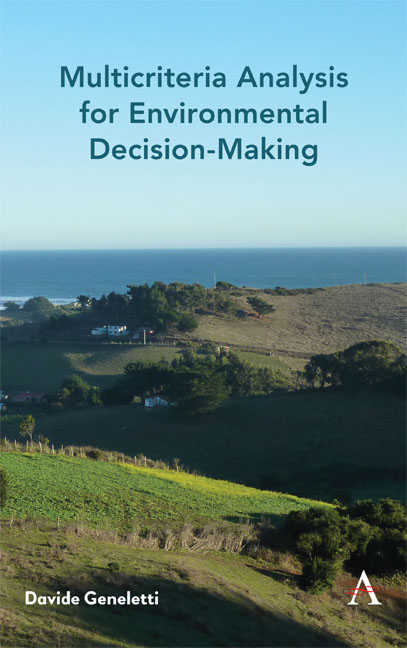Book contents
- Frontmatter
- Contents
- List of Figures
- List of Tables
- Acknowledgements
- List of Author and Contributors
- Introduction
- 1 Principles of Multicriteria Analysis
- 2 A Review of MCA Applications for Nature Conservation
- 3 Landfill Site Selection: Combining Spatial MCA with Stakeholder Analysis
- 4 Protected Area Zoning: Integrating Spatial MCA and Multi-objective Evaluation
- 5 Forest Landscape Restoration: Applying MCA to Design and Compare Options
- 6 Impact Assessment of Ski Areas: Combining GIS Indicators with MCA
- Conclusions
- Annex
- References
- Index
4 - Protected Area Zoning: Integrating Spatial MCA and Multi-objective Evaluation
Published online by Cambridge University Press: 16 July 2019
- Frontmatter
- Contents
- List of Figures
- List of Tables
- Acknowledgements
- List of Author and Contributors
- Introduction
- 1 Principles of Multicriteria Analysis
- 2 A Review of MCA Applications for Nature Conservation
- 3 Landfill Site Selection: Combining Spatial MCA with Stakeholder Analysis
- 4 Protected Area Zoning: Integrating Spatial MCA and Multi-objective Evaluation
- 5 Forest Landscape Restoration: Applying MCA to Design and Compare Options
- 6 Impact Assessment of Ski Areas: Combining GIS Indicators with MCA
- Conclusions
- Annex
- References
- Index
Summary
Context
Environmental decision-making problem
Optimizing the multiple use of land is a challenge for today's governments and land managers. To achieve this, they need to assess land properties for their environmental, economic and social importance and derive suitable legislation and management plans. These plans should satisfy the demand for multiple land uses, while protecting natural resources. In protected area planning, land properties are assessed with different, possibly conflicting, objectives. Production, hunting, fishing and recreational use cause disturbances, such as direct reduction of species populations, habitat degradation and fragmentation. These disturbances in turn may influence ecosystem composition and processes (Allison 1996; Hobbs 1993; Moleele and Mainah 2003; Noss 2000) or change behavioural patterns of species (Creachbaum et al. 1998).
Park planners and managers consequently face the problem of selecting the most appropriate evaluation framework and indicators. Planning and management decisions will also be strongly influenced by the type and amount of information already available, the size of the area and the legislation within which the planning exercise needs to fit. Arguably, one of the most important elements of a protected area plan is the zoning scheme. Through zoning, specific uses – and constraints – are assigned to different land units. Typically, zoning schemes consist of core areas, where strict nature conservation is enforced, and areas where gradually more intensive human presence and activities are allowed. In practice, planners and managers need to evaluate the spatial distribution of land properties, and decide upon where to restrict or stimulate certain activities or where to implement measures to protect natural resources.
Setting the zoning scheme for a protected area is a decision-making problem that inherently requires the evaluation of multiple land attributes according to multiple objectives. In addition, the processes that lead to a zoning proposal should be transparent, and the evaluation of land properties scientifically sound. Many studies have revealed the potential contribution of MCA to similar processes (Bojórquez-Tapia et al. 2004; Crossman et al. 2005; Hjortsø et al. 2006; Keisler and Sundell 1997; Ridgley and Heil 1998; Villa et al. 2002).
Case study description
This case study concerns the zoning of a terrestrial protected area: the Paneveggio-Pale di S. Martino (PPSM) Natural Park, located in north-eastern Italy.
Information
- Type
- Chapter
- Information
- Multicriteria Analysis for Environmental Decision-Making , pp. 47 - 62Publisher: Anthem PressPrint publication year: 2019
